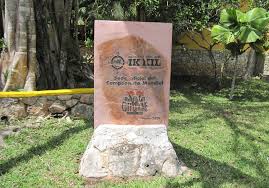The Maya name "Chichén Itzá" means "At the mouth of the well of the Itzá."
The name is spelled Chichén Itzá in Spanish, and the accents are sometimes maintained in other languages to show that both parts of the name are stressed on their final syllable.
Chichén Itzá is located in the eastern portion of Yucatán state in Mexico. The northern Yucatán Peninsula is arid, and the rivers in the interior all run underground. There are two large, natural sinkholes, called cenotes, that could have provided plentiful water year round at Chichén Itzá, making it attractive for settlement. Of the two cenotes, the "Cenote Sagrado" or Sacred Cenote, is the most famous. According to post-Conquest sources (Maya and Spanish), pre-Columbian Maya sacrificed objects and human beings into the cenote as a form of worship to the Maya rain god Chaac. Edward Herbert Thompson dredged the Cenote Sagrado from 1904 to 1910, and recovered artifacts of gold, jade, pottery and incense, as well as human remains. A study of human remains taken from the Cenote Sagrado found that they had wounds consistent with human sacrifice. However our tour guide, a descendant of the Maya was insistent that the Maya community did not make human sacrifice.
 |
| Typical souvenir trader |
 |
| Castillo de Kukulcan |
 |
| Templo del Jaguar |
 |
| Carvings in the Juego de Pelota |
 |
| Juego de Pelota - Balls were thrown through the hoop |
 |
| Local Resident |
 |
| Skull Platform - Annual ceremonies held here to remember the dead. |
 |
| Platforma de Venus |
 |
| Selfie at Castillo Kukulcan |
 |
| Grupo de las Mil Columnas |
 |
| El Osario |
 |
| El Caracol Observatorio |
Ik Kil is a well known cenote outside Pisté in the Municipality of Tinúm, Yucatán, Mexico, It is located in the northern centre of the Yucatán Peninsula and is part of the Ik Kil Archeological Park near Chichen Itza. It is open to the public for swimming and is often included in bus tours.
 The cenote is open to the sky with the water level about 26 metres (85 ft) below ground level. There is a carved stairway down to a swimming platform. The cenote is about 60 metres (200 ft) in diameter and about 40 metres (130 ft) deep. There are vines which reach from the opening all the way down to the water along with small waterfalls. There are black catfish which swim in the cenote. Cenote Ik Kil is sacred to the Mayans and the Mayans used this cenote for both relaxation and ritual services.
The cenote is open to the sky with the water level about 26 metres (85 ft) below ground level. There is a carved stairway down to a swimming platform. The cenote is about 60 metres (200 ft) in diameter and about 40 metres (130 ft) deep. There are vines which reach from the opening all the way down to the water along with small waterfalls. There are black catfish which swim in the cenote. Cenote Ik Kil is sacred to the Mayans and the Mayans used this cenote for both relaxation and ritual services.
 |
| Cenote - 'Ik Kill' |
 |
| Inside the Cenote cavern |
 |
| The view from the bottom of the Cenote |
 The cenote is open to the sky with the water level about 26 metres (85 ft) below ground level. There is a carved stairway down to a swimming platform. The cenote is about 60 metres (200 ft) in diameter and about 40 metres (130 ft) deep. There are vines which reach from the opening all the way down to the water along with small waterfalls. There are black catfish which swim in the cenote. Cenote Ik Kil is sacred to the Mayans and the Mayans used this cenote for both relaxation and ritual services.
The cenote is open to the sky with the water level about 26 metres (85 ft) below ground level. There is a carved stairway down to a swimming platform. The cenote is about 60 metres (200 ft) in diameter and about 40 metres (130 ft) deep. There are vines which reach from the opening all the way down to the water along with small waterfalls. There are black catfish which swim in the cenote. Cenote Ik Kil is sacred to the Mayans and the Mayans used this cenote for both relaxation and ritual services.





























No comments:
Post a Comment
We are interested to recieve your feedback and comments. Please Enter your comments here.